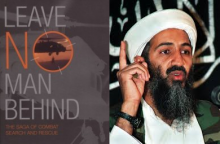Three years after the SEAL assault on the Pakistani compound and the killing of Osama bin Laden by a team of dedicated Navy SEALs flying sophisticated helicopters of the same type used by our Special Forces and highly trained Combat Search and Rescue forces, it is worth asking, as Rear Admiral George Tarrant (played by Fredric March) famously asked in the 1954 movie, Bridges at Toko Ri, “Where do we get such men?”
Our book, Leave No Man Behind, tells these stories – over a century of heroes going into harm’s way – literally into the teeth of death – to rescue their comrades. Here is what other writers thought of it:
An important and comprehensive work on that most American of military imperatives–going in harm’s way to get one of our own.
Dick Couch
Author of The Sheriff of Ramadi and Chosen Soldier (and ten other books)
Combat search and rescue (CSAR) has evolved into one of the most complex operations in war. Modern rescues often involve dozens of aircraft, and hundreds of military personnel-all this to save just one person! Why does the United States commit so many resources to this endeavor? Why do its Armed Forces consider it a sacred duty to leave no man behind? George Galdorisi and Tom Phillips explore these questions in their comprehensive history of CSAR from World War I through the Global War on Terrorism. In doing so, they help explain why CSAR has become a fundamental element of the American way of war.
Dr. John Sherwood
Author of: Afterburner: Naval Aviators and the Vietnam War and Officers in Flights Suits: The Story of American Air Force Fighter Pilots in the Korean War.



Post a Reply